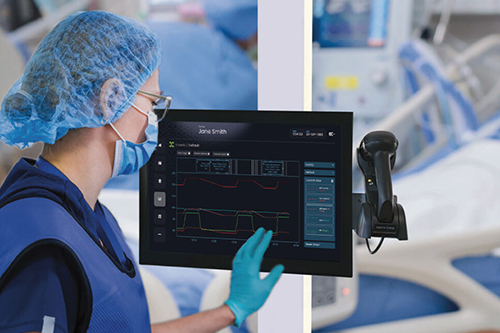Telemedicine experienced a boom after the pandemic, with approximately 37% of US adults relying on the service for regular healthcare. Perhaps most critical is the rise of the telemedicine intensive care unit (Tele-ICU, also known as virtual ICU), which uses secure audio and video to provide remote care to critically ill patients.
Studies show that Tele-ICU leads to lower mortality rates, especially in medium- and high-risk patients. This growing industry use of connected technologies can be pivotal in providing healthcare in rural areas, where hospitals (and particularly specialists) aren’t always available and accessible. This became a bigger problem as the industry experienced an unprecedented intensivist shortage in the aftermath of the pandemic.
Tele-ICU provides hospital partners with round-the-clock expertise for even the toughest cases to provide care without removing the patient from the support group in their community. Simply put, Tele-ICU programs raise the level of patient care, particularly in underserved areas.
Global Rise of the Virtual ICU
Virtual ICUs are becoming more prominent across the globe, especially in “tier 2” and “tier 3” cities where fewer doctors volunteer to work. Tier 2/3 cities are more rural areas outside the major metro, and this makes it harder to find skilled medical professionals to support patients.

Initially, virtual ICUs are typically established by larger, well-known hospitals and healthcare systems that have the required expertise and high reputation. Knowing they can receive care from a trusted resource helps put patients at ease during their most harrowing medical emergencies. However, the benefits and gains are immense to the smaller hospitals and facilities that don’t have the resources or staff in place to support the needs of their critical care patients.
Time is imperative in critical care situations, as a patient’s condition worsens and immediate attention is needed. Tele-ICUs have advanced technology that integrates various medical tools (like syringes, infusion pumps, and more) through software and IoT sensors. They transmit real-time data to allow for remote ICU monitoring of patients’ vital stats while ensuring they receive the necessary care.
The ideal solutions are those that are agnostic and can be interoperable with various medical equipment while also enabling data exchange with hospital information systems (HIS). They also provide outsourced IT and monitoring services while integrating artificial intelligence (AI) to improve data analysis.
The need for these vital services is growing, and data visibility is the key to continued adoption and growth.
The Importance of Data in Healthcare
Data visibility is essential to the success of Tele-ICU implementation. This data facilitates accurate decision-making while enabling immediate intervention in the case of emergencies. It also helps with predictive analytics, which improves patient outcomes by forecasting future potential issues and improving overall patient outcomes.
Technology allows for a collaborative care environment, with seamless communication without geographical restrictions. Imagine accessing an experienced oncologist or cardiologist to diagnose potential cancer or heart disease without forcing a patient to travel hundreds of miles outside of their home community.
This talent diversity across all geographic boundaries lays the foundation for more qualitative patient care, allowing proactive data analysis and care management while significantly improving the quality of care. It’s no wonder more healthcare providers are relying on Tele-ICU and remote ICU monitoring to raise the bar on medical care while educating both staff and patients in a better way moving forward.
Attention: Critical Access Hospitals with as few as 2 ICU beds! There is now an affordable and scalable solution for you to address your rural patient population. Find out more
Transforming Rural Healthcare
As technology continues to advance, telehealth presents an exciting frontier in healthcare, especially for underserved communities.
Integration with open and vendor-neutral platforms stands at the forefront of this transformation. The Patient-Centric Integrated Clinical Environment (ICE) represents a significant leap in ensuring seamless communication between medical devices and IT systems, marking a new era of interoperability in healthcare technology. This integration is not just about devices talking to each other; it’s about creating a cohesive, fluent system that enhances the delivery and efficiency of care.
AI and machine learning are also set to play a pivotal role in Tele-ICU’s evolution. These technologies will provide predictive analytics for patient care, making it possible to anticipate patient needs and potential complications before they become critical. This could mean a significant improvement in patient outcomes, especially in critical care scenarios where every second counts.
Additionally, enhanced data integration promises a unified patient view, consolidating all patient information into a comprehensive profile. This integration will equip healthcare providers with a more holistic understanding of a patient’s health status, leading to more informed and effective treatment plans.
Tele-ICU is a growing sector, allowing hospitals and healthcare systems to provide more holistic and specialized services to improve patient outcomes. This is especially true in less urban areas, where a smaller, more spread-out population can lead to difficulties.
If you are in a critical access or rural hospital struggling to get access to intensivists, there are now affordable virtual care solutions that can accommodate ICUs with as little as two beds. Our solution is revenue-generating versus being a cost center and scalable to accommodate varying bed sizes and patient loads. By partnering with telemedicine experts like AMD and their ICU technology partner DocBox, healthcare providers can work collaboratively to raise the overall quality of life throughout their communities.

Customize your
telemedicine solutions
Telemedicine and telehealth technology is not a one-size-fits all solution. We can tailor the solution to your specific needs.



